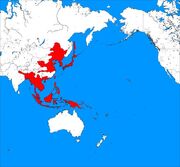1942[]
Battle of Midway[]
Before the Battle of Midway, at the Battle of Coral Sea, the USS Yorktown was sunk by Japanese torpedo bombers and caused the number of Americans present at the battle of Midway to be reduced by a third.
The superiority of the Japanese advanced fighter plane technology gave the Japanese forces an overwhelming advantage. US naval forces were unable to locate and engage the Japanese carriers. This gave the Japanese sufficient time to organize their forces and strike at the American fleet, sinking the USS Enterprise and severely damaging the carrier Hornet. Admiral Spruance is killed in the aerial bombardment on his flagship. Midway Island is successfully invaded, and the Japanese make use of the surviving airfield to launch air raids over Oahu in the Hawaiian Islands.
Post-Battle[]
Soon afterwards, in July of 1942, Admiral Isoroku Yamamoto successfully led the invasion of New Caledonia, Samoa and Fiji. This was coupled with Admiral Chiuchi's strike on the Aleutian Islands, which was also a success. American resistance in both areas was severely reduced by the loss of the remainder of its naval power at Midway.
Resistance by the Island Defense Battalion of the U.S. Marine Corps at Pago Pago was epic. A small unit of the survivors of 3rd company established a stronghold in the Sadie Thompson Hotel and held off over 500 Japanese troops of the 2nd Kure Kaigun Rikusentai, for three days before the Marines surrendered. The surviving 14 Marines were executed, and a retaliation targeting the population of Tuituila rivaled the atrocities of Nanking.
Invasion of Hawaii[]
From August 30th to September 7th of 1942, Japan conducted its invasion of Hawaii. The battle was long and arduous. The bulk of the remaining Pacific American forces were stationed on Oahu, Maui and the big island of Hawaii, but the lack of logistical support from mainland America and the overwhelming size of the surrounding Japanese invasion fleet caused the Americans to capitulate. The last American troops surrendered in Lahaina, Maui, TH, on September 7th, 1942. In total, 26,000 Americans were lost in the defense of the Territory of Hawaii.
Forced to the negotiation table after losing the Territory of Hawaii and the Aleutian Islands, Japanese and American forces agreed to meet in Vladivostok, USSR in order to discuss a ceasefire. The Soviet Union, wishing to avoid a two-front war, and aware of the symbolism of the United States facilitating the end of the 1905 Russo-Japanese war, was quick to intervene and help negotiate peace.
The "Japanization" of the Hawaiian Islands is quick and ruthless. The coronation of King Kamehameha VI on November 3rd, 1942 and the simultaneous inclusion of the Kingdom of Hawaii into the Japanese Empire sealed the fate of the island chain stretching from Midway to the big island of Hawaii, and at the same time, the fate of the western Pacific Ocean.
On December 7th, 1942, the Cartagena Entente is signed, creating a co-defense treaty between the Empire of Japan and Colombia.
1943[]
Japanese Consolidation[]
Meanwhile, Japan is busy consolidating and solidifying its power in the Pacific. On February 2nd, Japanese forces destroyed the last remaining resistance on the island of New Guinea, leaving Australia and New Zealand vulnerable to attack. Australia calls on the United States for aid, but the US does not wish to fight a naval battle with so few remaining ships. Instead, America sends 10,000 infantry troops that will fight under the Australian flag in the event of a Japanese invasion.
Invasion of Australia[]
On April 22nd, 1943, the Japanese made twin landings at Weipa and Darwin In the Northern region of Australia. The Australian Defense Forces were ill-prepared for the ruthless and determined Japanese forces and were quickly forced out of the majority of Queensland and the Northern Territory within weeks. Aid from United States forces at this time was sadly limited, as they were confined to protecting Canberra, Sydney and Melbourne on the southeastern coast. The only true resistance met by Japanese forces in the western part of Australia occurred at Perth, but was quickly subdued by a Japanese naval bombardment of the city. In the major cities, the fighting was more intense. The US garrisons would not give up their posts as easily as the ADF. However, a lack of supplies and support forced the US and ADF forces back to a small area surrounding the capital city, Canberra.
The Christmas Agreement[]
On Christmas Day, 1943, British, Australian and Japanese delegates met in Adelaide and signed a temporary ceasefire, which was effective until a permanent treaty could be decided upon. The United States was also reprimanded for its actions at the meeting and was forced to pay $500 million in war reparations, even though no American representatives had been present at the meeting.
1944[]

Treaty of Peking[]
On February 19th, 1944, Japanese, Australian, British, Vichy French, German, and Portuguese officials met in Peking in order to negotiate a permanent peace treaty. One week later, on February 26th, they signed the Treaty of Peking. In the treaty, Japan agreed to return sovereign control of Australia. However, the British Commonwealth and allied nations had to recognize the permanent annexations of the Japanese Empire. All possessions of the European nations and Australia, including Hong Kong, Macao, Tonkin, Annam, and Cochin, along with Burma, the Dutch East Indies, and Malaya are permanently ceded to the Japanese Empire. With the exception of Australia and New Zealand, Japan now controls the entire Pacific Ocean and south and central eastern mainland Asia, in the Greater Pan Asian-Pacific Co-Prosperity Sphere. Japan is now the known as the Empire of Nehon, Manchukuo, Siam, Hawaii and Great Nesia.
